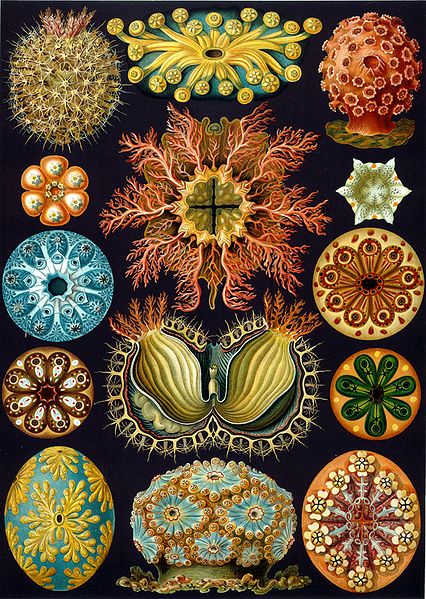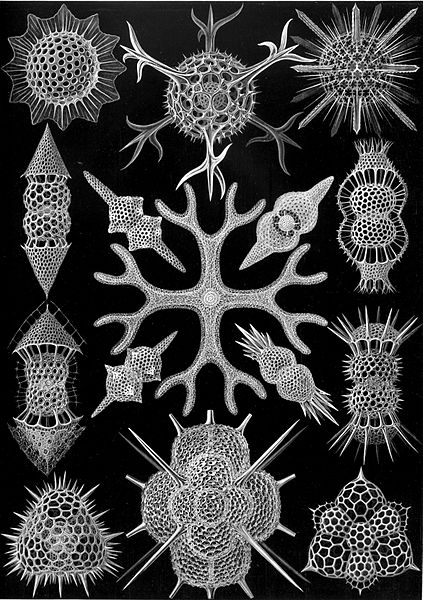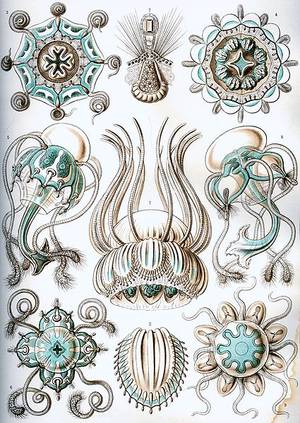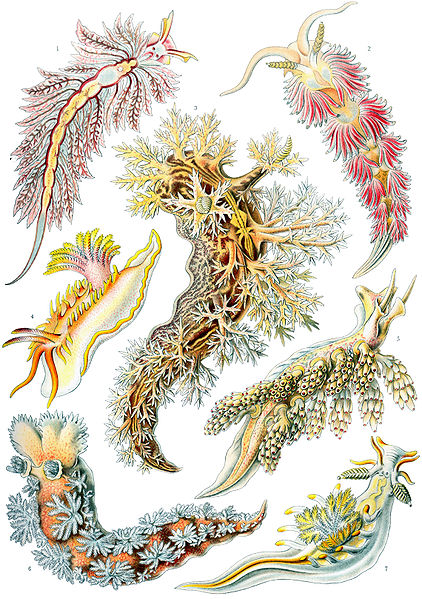Revealing ocean wonders before underwater photography
Interview with
Ernst Haeckel's drawings of the intricate sealife were a sensation among scientists and artists alike.
Helen - First of all Philip, just who was Ernst Haeckel and what sort of things did he get up to?
 Philip - Well he was a zoologist, or biologist, or call it what you will, someone who was interested in natural history, at the end of the nineteenth century. He was a professor of zoology at the University of Jena in Germany. And there he was one of the key promoters of Darwinism in Germany. He took Darwin's ideas and popularised them there, but he popularised them very much in his own way, it was a way that actually slightly baffled Charles Darwin.
Philip - Well he was a zoologist, or biologist, or call it what you will, someone who was interested in natural history, at the end of the nineteenth century. He was a professor of zoology at the University of Jena in Germany. And there he was one of the key promoters of Darwinism in Germany. He took Darwin's ideas and popularised them there, but he popularised them very much in his own way, it was a way that actually slightly baffled Charles Darwin.
He had an idea, I suppose, that all life is guided by organisational forces and principles. So it was quite an unorthodox kind of Darwinism.
Helen - And that sort of idea of shapes and patterns and organisation, that spilled over into this book that he produced Kunstformen de Natur, or Art Forms of Nature, which was this series of intricate drawings of living organisms, many of them from the sea.
Philip - Yes, well this was a series that Haeckel produced between 1899 and 1904 and he was an extraordinarily good draftsman. He did all the drawings himself. Some of them were of large creatures like fishes and birds and so forth, but a lot of them were microscopic creatures that he had found looking through the microscope he'd found in seawater.
They were organisms with exotic and unfamiliar names, things called radiolarians and diatoms, coccolithophores and dinoflagellates. And all of these are essentially single-celled organisms. Some are plants, some are kinds of plankton. Others are very primitive forms of animals called protozoa. And all of them build protective shells that have the most extraordinary shapes, and this was what excited Haeckel because this seemed to lend some support for his idea that the world, that life really is permeated by these organisational forces that operate all the way from very primitive, single-celled creatures, all the way through to higher organisms.
diatoms, coccolithophores and dinoflagellates. And all of these are essentially single-celled organisms. Some are plants, some are kinds of plankton. Others are very primitive forms of animals called protozoa. And all of them build protective shells that have the most extraordinary shapes, and this was what excited Haeckel because this seemed to lend some support for his idea that the world, that life really is permeated by these organisational forces that operate all the way from very primitive, single-celled creatures, all the way through to higher organisms.
So he looked at countless examples of these shapes in the microscope and drew them in the most elaborate way in this book Art Forms in Nature.
And the drawings that he made turned out to be very influential among some artists and designers at the time. They just found a huge amount of inspiration in these pictures.
Helen - Am I right it's the Art Nouveau movement that embraced a lot of these shapes and patterns that Haeckel came up with?
Philip - Yes, they're very characteristic of what we now associate with Art Nouveau. And some of the artists from that movement were inspired to make designs of things like furniture, that were based on some of the shapes of the radiolarians that Haeckel had drawn.
Helen - Was he a huge hit at the time? Did lots of people go out and buy this book?
 Philip - Yes they did. Well certainly artists did. And you can see why when you look at the book. It is stunning. It's stunning but also very weird. These shapes that were found in the exoskeletons of these tiny creatures were like nothing we'd seen before in the living world.
Philip - Yes they did. Well certainly artists did. And you can see why when you look at the book. It is stunning. It's stunning but also very weird. These shapes that were found in the exoskeletons of these tiny creatures were like nothing we'd seen before in the living world.
In fact when some of these creatures were first observed in the early 19th century when the ones called coccolithophores were first observed, people weren't sure whether what they were seeing were the products of living creatures or some kind of strange crystal. Because they had this very strange, orderly pattern to them, but also extremely elaborate.
They seem to stand at this juncture between the living and the non-living worlds. They are purely, completely the product of living creatures but it also turns out they are shaped by the same sorts of forces that can organise non-living systems things like bubble rafts and foams.
So they are very, very unusual. It just seems that artists at the time were completely captivated that things like this could exist in the world at such a tiny scale.
Helen - And would you say that Haeckel's work continues to have a legacy today? Do people still look to his work for inspiration or for ideas?
Philip - Well, yes they do. I think certainly for inspiration because whatever you make of Haeckel, he was quite a controversial character, the images that he's left us with are still as beautiful as ever, as striking as ever.
One has to say that occasionally you suspect that actually Haeckel was slightly  embellishing them. Certainly the way he arranged his pages was very decorative. So this wasn't a straight scientific record. He was clearly trying to do something artistic with this too, and sometimes he probably embellished the shapes that he saw to make them more regular and orderly.
embellishing them. Certainly the way he arranged his pages was very decorative. So this wasn't a straight scientific record. He was clearly trying to do something artistic with this too, and sometimes he probably embellished the shapes that he saw to make them more regular and orderly.
Nevertheless, what his artwork did show us was that there does seem to exist at all levels in nature some kind of pattern and form and symmetry, and it's really that that is inspiring in Haeckel and was really that that inspired the first thorough study of pattern and form in nature which was made in 1917 by a Scottish zoologist called Darcy Wentworth Thompson. Darcy Thompson included a lot of Haeckel's illustrations in his great book which was called On Growth and Form.
Find out more
Philip Ball









Comments
Add a comment